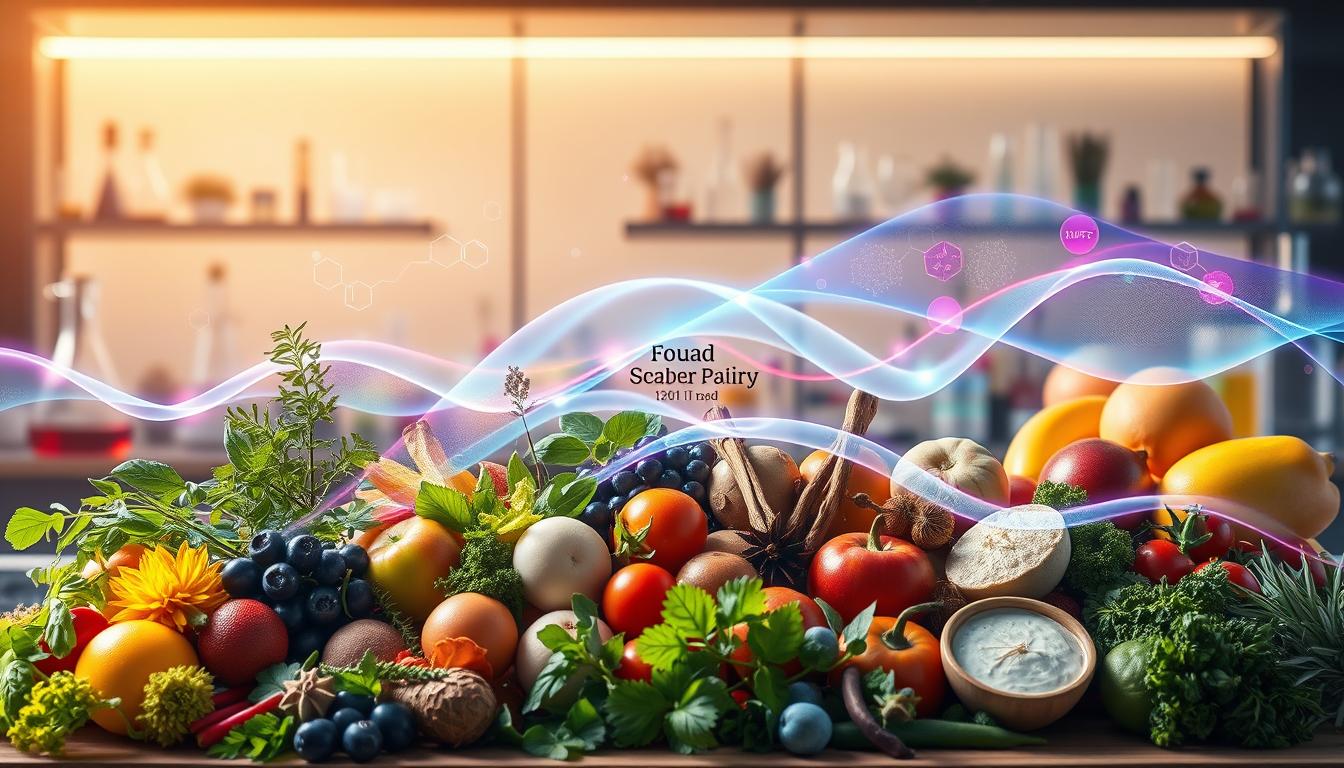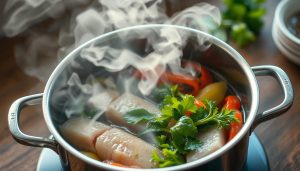Did you know 75% of memorable food pairings share at least three aromatic compounds? This invisible chemistry explains why classic duos like coffee and chocolate or lamb and rosemary create fireworks on your palate. Your brain isn’t just imagining that burst of satisfaction – it’s responding to molecular harmony.
Great combinations work because they balance contrasting elements while amplifying shared flavor molecules. Take strawberries and basil: both contain methyl cinnamate, a compound that creates an irresistible synergy. Similarly, lemon’s acidity cuts through seafood’s richness because citric acid interacts with umami receptors.
This isn’t random luck. Chefs and scientists study how taste buds and olfactory receptors process flavor compounds. When ingredients share key molecules, your sensory system registers them as complementary. Texture and temperature also play roles – think crispy bacon balancing creamy avocado.
Key Takeaways
- Shared aromatic compounds create natural harmony between ingredients
- Your senses process flavor through both taste buds and smell receptors
- Successful pairings balance contrast and similarity
- Professional chefs use molecular science to craft combinations
- Texture and temperature enhance flavor compatibility
Understanding these principles transforms how you approach cooking and eating. You’ll start recognizing why apple pie needs cinnamon or why horseradish elevates roast beef. This knowledge turns meal preparation from guesswork into strategic pairing – where every bite becomes a calculated delight.
Introduction to the Art and Science of Food Pairing
Imagine a canvas where every brushstroke is a chemical reaction. Flavor pairing blends creative intuition with hard data – a fusion that transforms ordinary meals into multisensory journeys. This discipline reveals why certain ingredients feel destined to unite, while others clash like mismatched puzzle pieces.

Dr. Lillian Carter’s research shows that exceptional flavor combinations engage more than your taste buds. They create dialogues between aroma molecules, texture contrasts, and even childhood memories. “The crunch of a fresh baguette enhances creamy soups because your brain registers contrast as complexity,” she explains.
Modern cooking techniques now merge centuries-old traditions with lab-grade precision. Chefs analyze molecular structures to predict successful matches, while still honoring cultural flavor histories. Your morning coffee’s partnership with cinnamon? That’s science validating generations of instinctive pairings.
Three pillars define this art science approach:
- Chemical compatibility between aromatic compounds
- Texture interactions that create mouthfeel dynamics
- Psychological factors influencing perception
This knowledge transforms your kitchen into a creative laboratory. You’ll start seeing ingredients as bundles of molecules waiting to harmonize – whether crafting avant-garde dishes or perfecting family recipes. The world of flavor becomes a playground where rules guide innovation rather than restrict it.
The Science Behind Food Pairing
What if your favorite flavor combinations could be decoded like a chemical formula? Modern science reveals that successful pairings rely on molecular matches you can’t see but definitely taste. Your senses become a laboratory, analyzing invisible connections between ingredients.

Aromatic Compounds and Flavor Profiles
Every ingredient contains unique aroma molecules that determine compatibility. Coffee’s 700+ aromatic components – from vanilla to chili notes – explain why it pairs with chocolate or citrus. When foods share key compounds, your brain registers them as harmonious.
“Shared flavor compounds act like molecular handshakes between ingredients,” explains Dr. Tiago Simas of Cambridge University.
This table shows how common foods connect through shared molecules:
| Ingredient 1 | Ingredient 2 | Shared Compound |
|---|---|---|
| Tomato | Basil | Eugenol |
| Strawberry | Coriander | Decadienal |
| Beef | Mushroom | Octenol |
The Role of Taste and Olfaction
Your 9,000 taste buds only detect five basic flavors. Meanwhile, 10 million smell receptors process thousands of aroma signals. This explains why sniffing wine enhances its flavor – your nose does most of the work.
Three factors determine flavor perception:
- Molecular matches between ingredients
- Texture contrasts that stimulate multiple senses
- Memory associations triggered by aromas
When you bite into tomato-basil bruschetta, shared eugenol molecules create instant chemistry. Your sense of smell amplifies this connection, making the pairing feel instinctively right. This science behind flavor explains why some duos become classics.
Culinary Pioneers and Their Influence on Flavor Matching
What separates culinary genius from kitchen chaos? Visionary chefs like Heston Blumenthal transformed cooking into a lab experiment where molecular science meets mouthfeel. His work proves that flavor pairing isn’t just about tradition – it’s about daring to question every assumption.

Heston Blumenthal’s Experimental Innovations
In 1992, Blumenthal shocked diners by pairing salty caviar with sweet white chocolate. This combination defied centuries of culinary norms but revealed a molecular truth. “We discovered both ingredients share key fatty acids and amines,” he explains. The result? A velvety fusion where briny pops complement creamy sweetness.
Blumenthal’s method involves precise ratios: 30g Sevruga caviar to 125g white chocolate. Melted into discs and topped with roe, the flavor release mimics chemical bonding. Your tongue becomes a test tube, decoding layered textures and shared compounds.
Scientific Collaborations in Flavor Pairing
The chef’s partnership with Firmenich scientist François Benzi changed how professionals approach flavor pairing. Their research showed successful matches require:
- Shared volatile compounds (like caviar’s trimethylamine)
- Contrasting textures for sensory excitement
- Temperature control to optimize aroma release
This collaboration birthed a new culinary standard. Chefs now analyze ingredients through gas chromatography before plating. Whether you’re pairing dark chocolate with blue cheese or testing avant-garde duos, Blumenthal’s work proves science amplifies creativity.
Why Some Foods Pair Better Than Others
Every memorable combination begins at the molecular level. Ingredients sharing aromatic compounds create invisible bridges your senses recognize as harmonious. Flavor pairings thrive when these chemical connections meet contrasting textures and temperatures.

Scientific analysis reveals why classics like tomato-basil work so well. Both contain eugenol – a compound creating earthy sweetness. Modern platforms like foodpairing.com analyze these connections through databases tracking:
| Ingredient | Best Match | Shared Molecules |
|---|---|---|
| Dark Chocolate | Blue Cheese | 5 aldehydes |
| Pineapple | Vanilla | 3 lactones |
| Pork | Clove | Eugenol, caryophyllene |
More shared compounds often mean stronger potential, but exceptions exist. Coffee and lemon share 12 molecules yet rarely combine well. “Quantity matters less than compound dominance in the overall profile,” notes foodpairing.com’s lead chemist.
Traditional combinations gain scientific validation through this approach. Cinnamon-apple pairings succeed because both contain cinnamaldehyde. Your brain registers this overlap as familiarity layered with complexity.
Modern chefs use these principles to push boundaries while respecting culinary heritage. Understanding molecular connections turns random experiments into strategic creations. You’re not just mixing ingredients – you’re conducting chemistry experiments that delight the senses.
Practical Tips for Experimenting with Flavor Combinations
Unlocking flavor magic begins with structured exploration. Platforms like foodpairing.com reveal that 80% of successful combinations stem from aroma matches. Start with ingredients you love, then let science guide your creativity.

Step-by-Step Guide to Creating Your Own Pairings
Begin with one core ingredient – say, ripe peaches. Research their dominant compounds (like gamma-decalactone) using free databases. Match them with foods sharing these molecules, such as coconut or bourbon.
Test combinations in small batches. Slice peaches thin, pair with shredded coconut, and evaluate:
- Balance between sweetness and acidity
- Texture contrast (juicy vs. crunchy)
- Aroma harmony during chewing
| Flavor Profile | Core Ingredient | Suggested Pair |
|---|---|---|
| Sweet | Honey | Goat Cheese + Thyme |
| Umami | Mushrooms | Miso + Walnut |
| Acidic | Yuzu | Salmon + Dill |
Building Your Personalized Flavor Pairing Chart
Organize successful matches in a three-column system:
- Primary ingredient + dominant compounds
- Confirmed partners with shared molecules
- Texture/temperature adjustments
Chef Elena Martinez advises: “Test new dishes with at least three people. Different palates catch nuances you might miss.” Update your chart quarterly – seasonal produce introduces fresh experiences.
Remember: Great cooking balances data and daring. Your chart becomes a living document where science meets personal taste.
Attractive Pairing Ideas for Home and Professional Kitchens
Transform your kitchen into a flavor laboratory with combinations that spark joy on every plate. Master both timeless classics and avant-garde matches using principles rooted in chemistry and creativity.
Classic Combinations You Can Trust
Tomato and basil’s romance isn’t accidental – they share eugenol molecules creating earthy harmony. For desserts, strawberries dipped in aged balsamic vinegar showcase how acidity amplifies natural sweetness. Try these proven duos:
| Base Ingredient | Perfect Partner | Science Behind It |
|---|---|---|
| Oysters | Champagne | Salt-acid contrast |
| Peanut Butter | Jelly | Fat-fruit synergy |
| Coffee | Vanilla | Shared lactones |
Bold, Unconventional Pairings to Try
Shave aged Parmesan over dark chocolate mousse – umami notes deepen cocoa’s richness. Chef Marco Pierre White swears by this: “The salt-fat balance creates addictive complexity you can’t achieve through traditional methods.”
Experiment with these boundary-pushing combinations:
- Blue cheese + honeycomb (pungent meets floral)
- Grilled peaches + goat cheese + chili flakes
- Seared scallops + pumpkin purée + crushed hazelnuts
For dishes that wow guests, try coffee-rubbed pork with cherry compote. The caffeine enhances meat’s savory depth while fruit acidity cuts through fat. Remember: successful innovation starts with understanding molecular relationships, then bending the rules.
Conclusion
The secret to unforgettable flavors lies in balancing science with creative courage. Mark Zaslavsky of Marky’s Gourmet Foods reveals how caviar’s delicate profile demands precision – a reminder that even luxury ingredients thrive through thoughtful pairings. Chef Jean-Pierre Dubois champions experimentation: “Daring combinations birth groundbreaking dishes.”
Your cooking evolves when molecular insights meet instinct. Shared aromatic compounds become building blocks, whether crafting family meals or plating desserts for guests. This knowledge extends beyond the kitchen – balance acidity in cocktails or tannins in wine pairings using the same principles.
The world of flavor rewards those who explore. Start with familiar matches like coffee-vanilla, then venture into bold territory. Record successes in a tasting journal, noting texture contrasts and aroma harmonies. Over time, you’ll develop an intuitive sense for connections others might miss.
True mastery comes through practice. Each meal becomes an opportunity to test theories and refine techniques. As you experiment, remember: every iconic pairing began as someone’s wild idea. Your next creation could redefine what flavors belong together.



